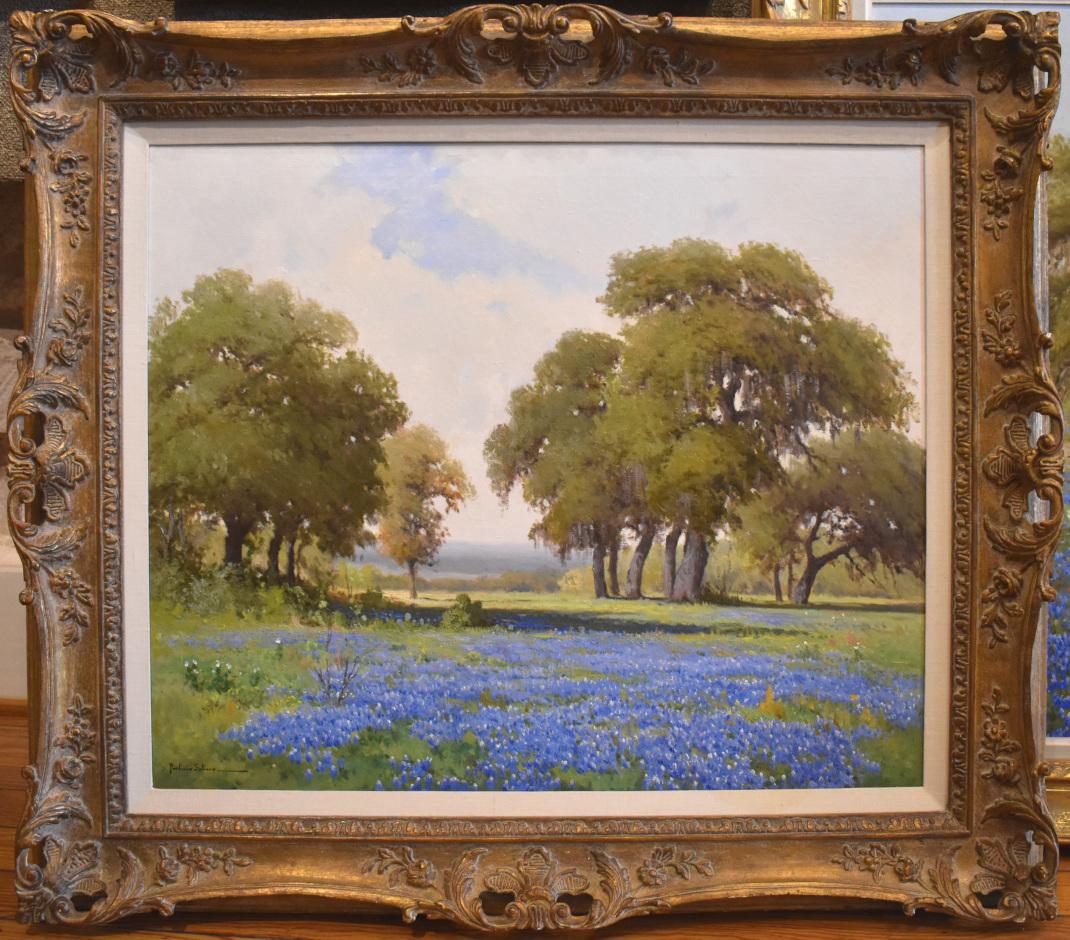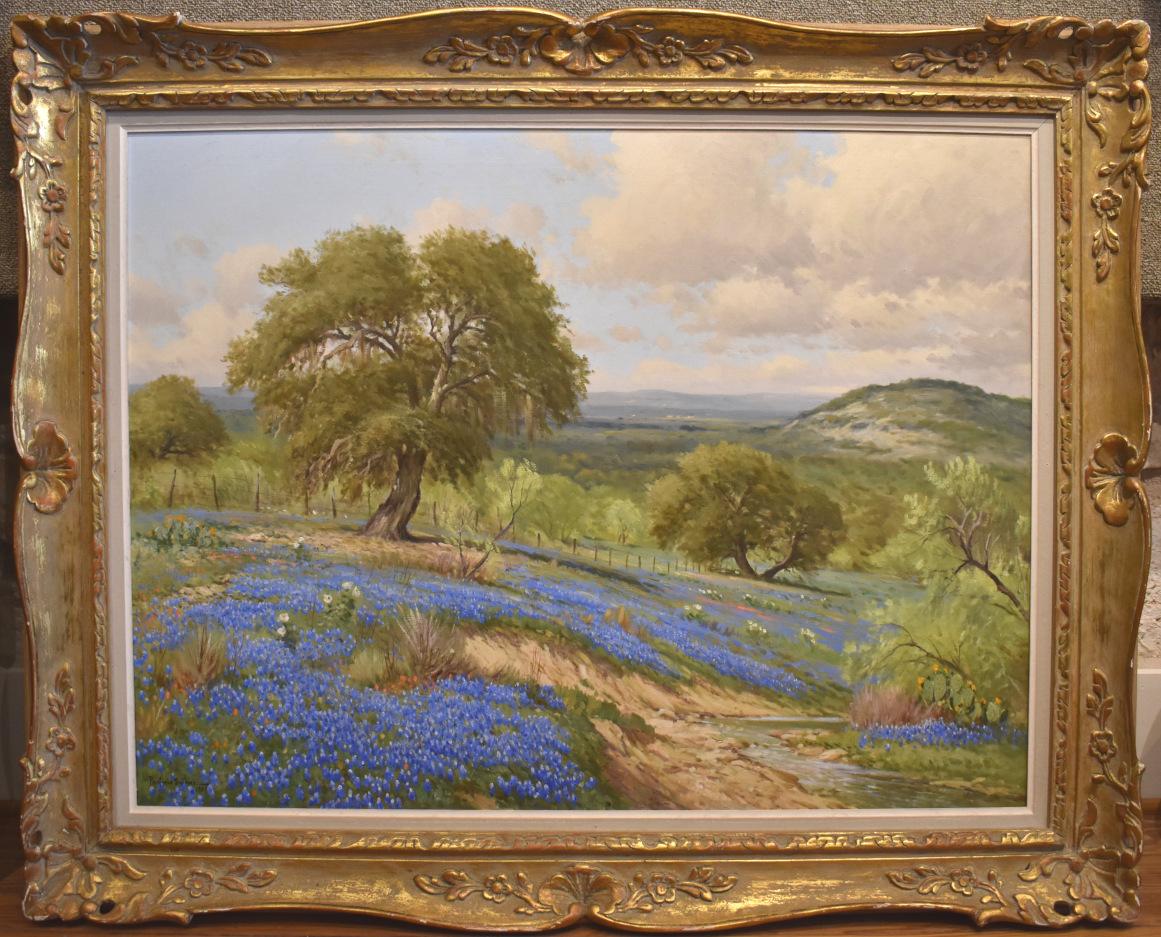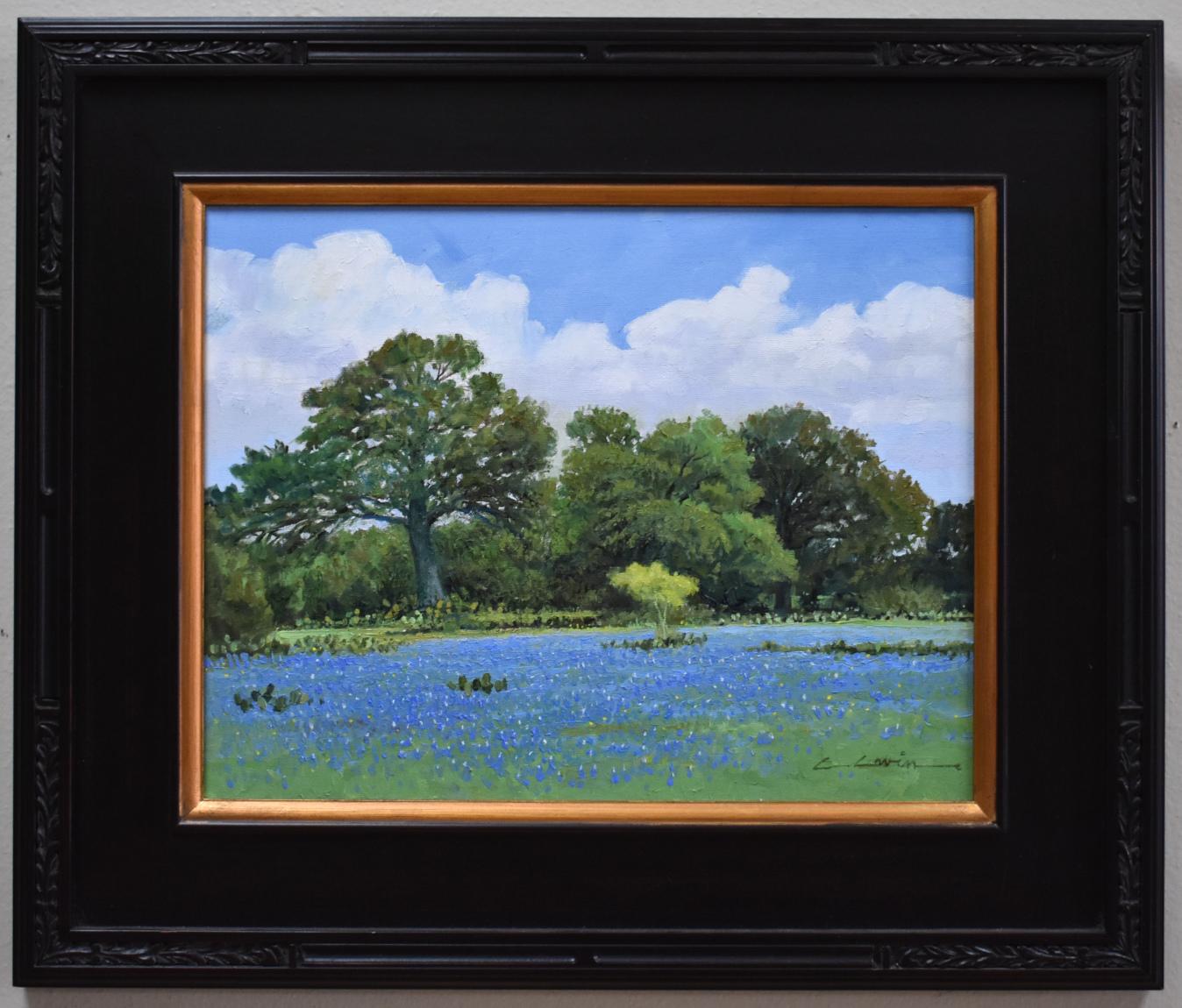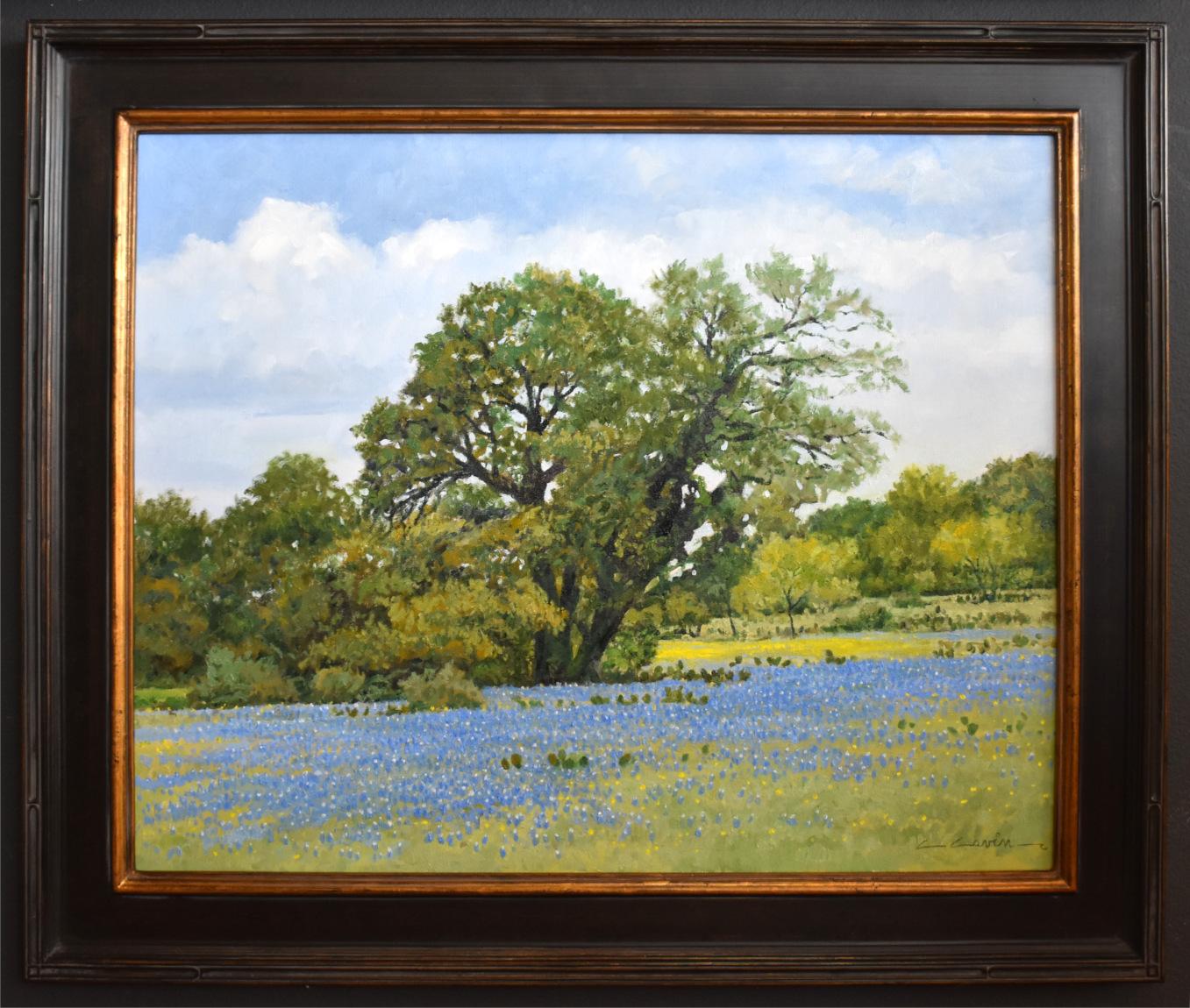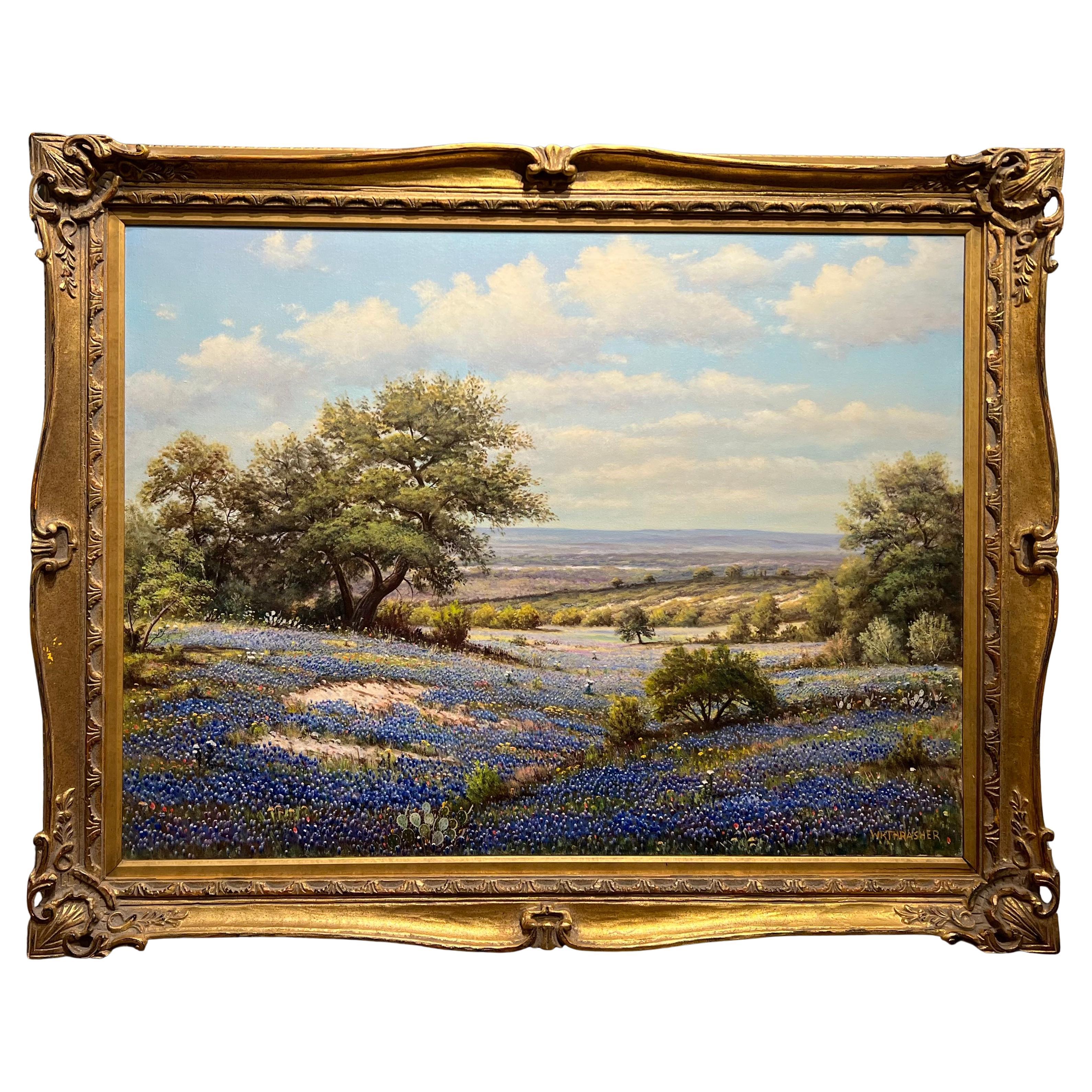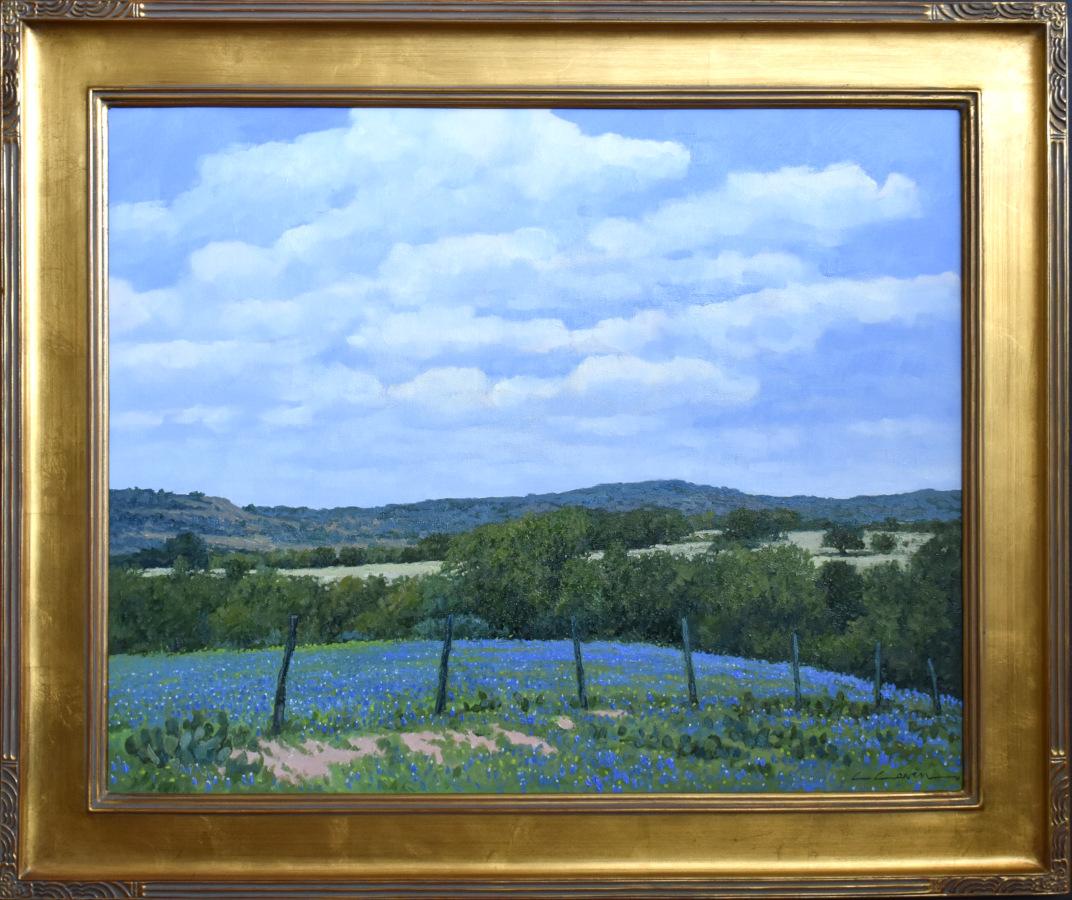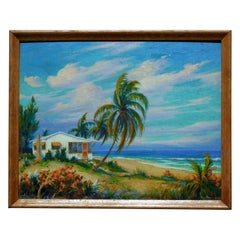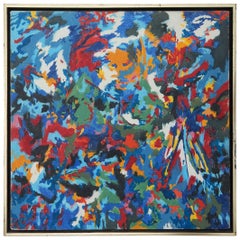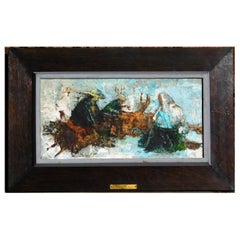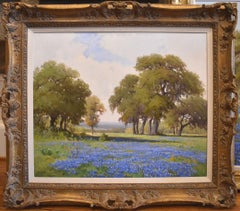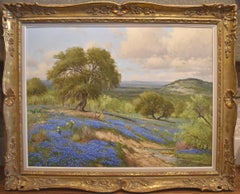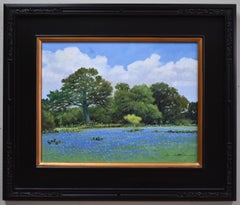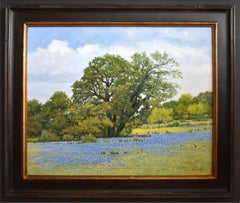Items Similar to William A. Slaughter Texas Bluebonnet Painting, Circa 1970's
Want more images or videos?
Request additional images or videos from the seller
1 of 8
William A. SlaughterWilliam A. Slaughter Texas Bluebonnet Painting, Circa 1970'sCirca 1970's
Circa 1970's
$7,900
£5,957.38
€6,890
CA$11,083.66
A$12,320.17
CHF 6,457.97
MX$150,459.14
NOK 80,624.05
SEK 75,852.19
DKK 51,424.96
About the Item
Wonderful Bluebonnet subject oil on canvas by Texas artist William A. Slaughter (1923-2003). The work is in excellent condition and signed lower left.
Image 16"h x 19 ½” w. Frame 24" x 28" x 2”.
William A. Slaughter was born in San Antonio, Texas in 1923 and died in Dallas, Texas December 2003. His first call was to the ministry and after serving in the Air Force during WWII, he was ordained as a Lutheran pastor. This calling took him first to Lubbock, Texas, Mexico, and finally Dallas. It was during this ministry in Mexico that Mr. Slaughter began seriously to hear another call. Slaughter began painting and exhibiting at local art and craft shows after moving to Dallas. His church members began buying his paintings and before long he knew that he was going to have to make a life changing decision between the Ministry and art. Slaughter first belonged to and exhibited with the Artists and Craftsmen's Association of Dallas. In 1968, he was awarded first in landscape painting. In 1973, he was awarded first in still life painting. He was mostly self-taught and combined innate ability and persistence to create many Texas landscapes, seemingly everyone's favorite subject.
- Creator:William A. Slaughter (1923 - 2003, American)
- Creation Year:Circa 1970's
- Dimensions:Height: 24 in (60.96 cm)Width: 28 in (71.12 cm)Depth: 2 in (5.08 cm)
- Medium:
- Period:
- Condition:
- Gallery Location:Phoenix, AZ
- Reference Number:Seller: p59201stDibs: LU2749215075482
About the Seller
5.0
Gold Seller
Premium sellers maintaining a 4.3+ rating and 24-hour response times
1stDibs seller since 2024
38 sales on 1stDibs
Typical response time: 1 hour
- ShippingRetrieving quote...Shipping from: Phoenix, AZ
- Return Policy
Authenticity Guarantee
In the unlikely event there’s an issue with an item’s authenticity, contact us within 1 year for a full refund. DetailsMoney-Back Guarantee
If your item is not as described, is damaged in transit, or does not arrive, contact us within 7 days for a full refund. Details24-Hour Cancellation
You have a 24-hour grace period in which to reconsider your purchase, with no questions asked.Vetted Professional Sellers
Our world-class sellers must adhere to strict standards for service and quality, maintaining the integrity of our listings.Price-Match Guarantee
If you find that a seller listed the same item for a lower price elsewhere, we’ll match it.Trusted Global Delivery
Our best-in-class carrier network provides specialized shipping options worldwide, including custom delivery.More From This Seller
View AllCarl Brandien, The Vagabond Artist, Oil on Board, Florida Subject, 1944
Located in Phoenix, AZ
Carl Brandien Oil on Board. Florida Subject. In excellent condition.
Canvas size: 16"h x 20"w. Frame size: 17 ½h x 21 ½w. Signed lower right “Carl Brandien ‘44. Ft. Lauderdale, Fla.”...
Category
Mid-20th Century Landscape Paintings
Materials
Paint
John Harvey McCracken Minimalist Abstract Oil on Canvas, 1973
By John McCracken
Located in Phoenix, AZ
Bright, exciting painting by well known New York/New Mexico/California artist John McCracken.
Framed simply and in excellent condition. Signed on the verso and dated 1973.
Painting m...
Category
Late 20th Century Abstract Paintings
Materials
Paint
Gustave Baumann Color Woodblock - Rancho de Taos
By Gustave Baumann
Located in Phoenix, AZ
“Rancho de Taos” by well-known woodblock artist Gustave Baumann (1881-1971).
The medium is color woodblock. It's a beautiful print in excellent condition.
Baumann's personal Hand and...
Category
Mid-20th Century Landscape Prints
Materials
Woodcut
Jose Salazar Ruiz Esparza Mexican/American Artist, Modern Painting, Ca. 1960's
By Jose Salazar Ruiz Esparza
Located in Phoenix, AZ
Original Oil on Canvas by Jose Salazar Ruiz Esparza signed by the artist lower left.
The work presents in the original frame and is in excellent condition. Created circa 1960's.
The...
Category
1960s Figurative Paintings
Materials
Paint
H. Wilson Smith California Artist Abstract Painting, circa 1940s-1950s
By H. Wilson Smith
Located in Phoenix, AZ
H. Wilson Smith (1901-1981) California Artist
Oil on board in the original frame.
Painting measures 31 3/4" H x 27 3/4" W
Frame 22 3/4" H x 28 3/4" W.
Signed lower right “H. Wilson S...
Category
Mid-20th Century Abstract Paintings
Materials
Paint
Southern Woman Artist Grace Martin Taylor Watercolor - West Palm Beach
Located in Phoenix, AZ
Early Watercolor of West Palm Beach by Southern Woman Artist Grace Martin (Frame) Taylor.
The work is in excellent condition and nicely framed under glass.
Painting measures 11"h x 14"w. The frame is 19 5/8"h and 22"w.
The watercolor is signed and dated lower left and also titled and dated in graphite as well.
Grace Martin Frame Taylor (1903-1995), a native of Morgantown, West Virginia, launched a nearly forty-year affiliation with the Mason College of Music and Fine Arts, now part of the University of Charleston in West Virginia.
In 1921, Taylor enrolled at the University of West Virginia in her hometown; disappointed by the art curriculum, however, she left after just one year to attend the Pennsylvania Academy of the Fine Arts. She returned to the University of West Virginia in 1924 to finish her bachelor’s degree, selecting English as her major, with an emphasis on journalism; she eventually earned a master’s degree there in 1929.
Following her graduation, Taylor went to Provincetown, Massachusetts, and renewed her interest in art under the guidance of her distant cousin Blanche Lazzell. Both Provincetown and Lazzell had gained a significant reputation for a particular kind of color woodblock printmaking known as the white line method. Grace Taylor embraced this approach wholeheartedly; for twenty-eight summers she returned to Provincetown to advance her printmaking skills with Lazzell and Heinrich Pfeiffer. In the ensuing decades, she also studied under Hans Hofmann whom she called her “very favorite modern master.”
Taylor traveled to other destinations to further her education. In the late 1930s and early 1940s, she spent time at the Carnegie Institute of Technology in Pittsburgh; closer to home, she studied at the Old White Art Colony in White Sulphur Springs, West Virginia, and took lessons in portraiture in the capital city of Charleston...
Category
1940s Landscape Paintings
Materials
Watercolor
You May Also Like
"Lazy Days Blues" TEXAS BLUEBONNETS, NICE LARGER SIZE LANDSCAPE CIRCA 1950
By Porfirio Salinas
Located in San Antonio, TX
Porfirio Salinas
(1910-1973)
San Antonio Artist
Image Size: 25 x 30
Frame Size: 34 x 39
Medium: Oil on Canvas
Circa 1950
"Lazy Day Blues" Texas Bluebonnet
Biography
Porfirio Salinas (1910-1973)
Porfirio Salinas was a self-taught artist who painted landscapes of Central Texas with an emphasis on the vast bluebonnet fields that grow there in the springtime. Born in 1910 in Bastrop, Texas, he attended public schools in San Antonio. He also observed works in progress by the director of the San Antonio Art School, Jose Arpa, as well as landscape painter, Robert Wood. Wood is said to have paid Salinas five dollars a picture to paint bluebonnets because "he hated to paint bluebonnets". Salinas served in the military from 1943 to 1945. Although he was assigned to Fort Sam Houston, he was allowed to live at home. At the fort, Colonel Telesphor Gottchalk assigned him to paint murals for the officer's lounge and various other projects, and Salinas continued to be able to paint during his entire conscripted period. Even before he achieved notoriety among galleries, dealers, and museums, Salinas was widely followed and appreciated by many Texans, including former President Lyndon B. Johnson, who may be considered responsible for launching Salinas popularity beyond the boundaries of Texas. In 1973, Texas capital, Austin, honored Salinas for having "done much to bring the culture of Mexico and Texas closer together with his paintings". Salinas died in April 1973 in San Antonio, Texas.
From
the years of the Great Depression through President Lyndon Johnson's
Great Society of the 1960s, Texan Porfirio Salinas (1910-1973) remained
one of the Lone Star State's most popular artists. Today, his works
remain popular with Texas collectors and those who love landscapes of
the beautiful "Hill Country" that lies in the center of the
state. One of the first Mexican American painters to become
widely recognized for his art, Salinas was a favorite of President
Lyndon Johnson and his wife, Lady Bird Johnson, as well as of Sam
Rayburn, the longest-serving Speaker of the House of Representatives,
and Texas Governor John Connelly. In fact, President Johnson was so
enamored with his Salinas paintings that the artist will forever be
associated with America's first Texas-born President. Works by Porfirio
Salinas is in a number of museum collections, grace the halls of the
Texas State Capitol and the Governor's Mansion in Austin, and are
included in virtually every major private collection of Early Texas Art.
Porfirio
Salinas was born on November 6, 1910, near the small town of Bastrop,
Texas, about thirty miles from Austin. His father, Porfirio G. Salinas
(1881-1967), and his mother, Clara G. Chavez, struggled to make a
hardscrabble living as tenant farmers, but eventually were forced to
give up farming. The family moved to San Antonio, where Salinas' father
was able to get a job working as a laborer for the railroad, but the
scenic area around Bastrop, with its pine trees and the wide expanse of
the Rio Grande River, would forever remain a touchstone for the artist.
For the rest of his life, Salinas and his brothers went back frequently
to visit their grandmother in her little farmhouse. When in Bastrop,
Porfirio painted on the banks of the Rio Grande or in the groves of
pine trees. The Salinas family was close-knit, and Porfirio was the
middle child of five children, so he had an older brother and sister as
well as a younger brother and sister. His mother was a native of
Mexico, so throughout his childhood the family made the long drive to
Mexico to visit Clara Salinas' family.
As a child growing up in
the bi-lingual section of San Antonio, Salinas drew and painted
incessantly and by the time he was ten, he was already producing work
that was mature enough to sell to his schoolteachers. Many years later
in an article in the New York Times he was described as a "boy whose
textbooks were seldom opened and whose sketchbook was never closed."
Instead of studying, the young artist spent his spare time watching
artists paint in and around San Antonio. As an aspiring painter,
Salinas was fortunate to grow up in the historic city, which had the
most active art scene in Texas. It was his exposure to older,
professional painters that encouraged the precocious young painter to
leave school early in order to help his family and pursue a career as a
professional artist, despite his father's inability to see art as a
career with any future for his son.
When Salinas was about
fifteen he came to know the artist Robert W. Wood (1889-1979). He met
Wood while he was employed in an art supply store and he soon began to
work as an assistant to the English-born painter, who had moved from
Portland to San Antonio in 1924. Although the diminutive Englishman was
already an established professional artist, he did not have a great
deal of formal art training and so he was then studying with the
academically trained Spanish painter Jose Arpa (1858-1952) in order to
augment his knowledge and give his work a more polished look. Salinas
was an eager young man, and while working in Wood's downtown San
Antonio studio he learned to stretch canvases, frame paintings and to
sketch in larger compositions from small plein-air studies for the
English artist. He began to accompany Wood and Arpa to the hills
outside San Antonio, where they painted small Plein-air studies of
fields of blue lupin - the state flower, the famous "Bluebonnets" of
Texas - in the springtime and scenes of the gnarled Red Oaks as they
changed color in the fall. He was soon assisting Wood in the tedious
work of painting the tiny blue flowers that collectors wanted to see in
the landscapes they purchased of central Texas. According to a
1972 newspaper story, "Legend has it that one day in the 1920s artist
Robert Wood decided he could not bear to paint another bluebonnet in
one of his landscapes. He hired young Porfirio Salinas to paint
them in for him at five dollars a painting." Whether this story is
accurate or apocryphal isn't clear, but the ambitious and independent
young Salinas wasn't destined to be anyone's assistant for very long.
The
formative event of Porfirio Salinas' teenage years was the Texas
Wildflower Competitive Exhibitions, a Roaring-Twenties dream of the
eccentric oilman Edgar B. Davis (1873-1951). These competitive shows of
paintings of wildflowers and Texas life were mounted in San Antonio
from 1927 to 1929. Held at the newly opened Witte Museum each spring,
the exhibition featured large cash prizes donated by the philanthropic
Davis, which were an inducement for artists to travel from all over the
United States to paint in the Hill Country of Texas. The "Davis
Competitions," as they were known, helped to cement San Antonio's
reputation as an art center, a legacy that remains with the "River
City" today. The shows generated a great deal of excitement in the
area, helping to make celebrities of the some of the artists who had
already settled there and encouraging others to make San Antonio their
home. Over the three years that the wildflower competitions were held,
more than 300 paintings were exhibited, and many thousands of viewers
saw the paintings at the Witte Museum and on tours throughout the state
and in New York. Each year Davis would generously purchase the winning
paintings and then donate them to the San Antonio Art League. Young
Porfirio Salinas would have been able to not only watch his two mentors
- Robert W. Wood and Jose Arpa - paint the works that they entered in
the Davis Competitions, he would have been able to see Arpa take
several of the major prizes, receiving the judge's accolades for
"Verbena," "Cactus Flower" and "Picking Cotton," works that are still
on view at the San Antonio Art League Museum today. Unfortunately,
Davis eventually put his donations to work in other charitable
endeavors, bringing to an end the wildflower events, but only after
they inspired Salinas and other young painters and had helped to make
wildflower paintings the most sought-after subject for traditionalist
Texas collectors.
In 1930, when he was only twenty, Salinas
hung out a shingle and began to paint professionally, augmenting the
sales of his easel paintings with what little business he could garner
by painting signs for local concerns. It was a struggle for the young
artist to make a living, as the effects of the Great Depression were
settling in. His early works are very similar to those of Robert
Wood's, both in subject matter and treatment. Salinas did small
paintings of Bluebonnets for the tourists who visited San Antonio to
see the famous Alamo as well as paintings of the Texas missions...
Category
1950s Impressionist Landscape Paintings
Materials
Oil
"Bluebonnet Creek" Texas Hill Country 1957 39 x 49 Framed!!!
By Porfirio Salinas
Located in San Antonio, TX
Porfirio Salinas
(1910-1973)
San Antonio Artist
Image Size: 30 x 40
Frame Size: 39 x 49
Medium: Oil on Canvas
Dated 1957
"Bluebonnet Creek" Texas Hill Country
Biography
Porfirio Salinas (1910-1973)
Porfirio Salinas was a self-taught artist who painted landscapes of Central Texas with an emphasis on the vast bluebonnet fields that grow there in the springtime. Born in 1910 in Bastrop, Texas, he attended public schools in San Antonio. He also observed works in progress by the director of the San Antonio Art School, Jose Arpa, as well as landscape painter, Robert Wood. Wood is said to have paid Salinas five dollars a picture to paint bluebonnets because "he hated to paint bluebonnets". Salinas served in the military from 1943 to 1945. Although he was assigned to Fort Sam Houston, he was allowed to live at home. At the fort, Colonel Telesphor Gottchalk assigned him to paint murals for the officer's lounge and various other projects, and Salinas continued to be able to paint during his entire conscripted period. Even before he achieved notoriety among galleries, dealers, and museums, Salinas was widely followed and appreciated by many Texans, including former President Lyndon B. Johnson, who may be considered responsible for launching Salinas popularity beyond the boundaries of Texas. In 1973, Texas capital, Austin, honored Salinas for having "done much to bring the culture of Mexico and Texas closer together with his paintings". Salinas died in April 1973 in San Antonio, Texas.
From
the years of the Great Depression through President Lyndon Johnson's
Great Society of the 1960s, Texan Porfirio Salinas (1910-1973) remained
one of the Lone Star State's most popular artists. Today, his works
remain popular with Texas collectors and those who love landscapes of
the beautiful "Hill Country" that lies in the center of the
state. One of the first Mexican American painters to become
widely recognized for his art, Salinas was a favorite of President
Lyndon Johnson and his wife, Lady Bird Johnson, as well as of Sam
Rayburn, the longest-serving Speaker of the House of Representatives,
and Texas Governor John Connelly. In fact, President Johnson was so
enamored with his Salinas paintings that the artist will forever be
associated with America's first Texas-born President. Works by Porfirio
Salinas are in a number of museum collections, grace the halls of the
Texas State Capitol and the Governor's Mansion in Austin, and are
included in virtually every major private collection of Early Texas Art.
Porfirio
Salinas was born on November 6, 1910, near the small town of Bastrop,
Texas, about thirty miles from Austin. His father, Porfirio G. Salinas
(1881-1967), and his mother, Clara G. Chavez, struggled to make a
hardscrabble living as tenant farmers, but eventually were forced to
give up farming. The family moved to San Antonio, where Salinas' father
was able to get a job working as a laborer for the railroad, but the
scenic area around Bastrop, with its pine trees and the wide expanse of
the Rio Grande River, would forever remain a touchstone for the artist.
For the rest of his life, Salinas and his brothers went back frequently
to visit their grandmother in her little farmhouse. When in Bastrop,
Porfirio painted on the banks of the Rio Grande or in the groves of
pine trees. The Salinas family was close-knit and Porfirio was the
middle child of five children, so he had an older brother and sister as
well as a younger brother and sister. His mother was a native of
Mexico, so throughout his childhood the family made the long drive to
Mexico to visit Clara Salinas' family.
As a child growing up in
the bi-lingual section of San Antonio, Salinas drew and painted
incessantly and by the time he was ten, he was already producing work
that was mature enough to sell to his schoolteachers. Many years later
in an article in the New York Times he was described as a "boy whose
textbooks were seldom opened and whose sketchbook was never closed."
Instead of studying, the young artist spent his spare time watching
artists paint in and around San Antonio. As an aspiring painter,
Salinas was fortunate to grow up in the historic city, which had the
most active art scene in Texas. It was his exposure to older,
professional painters that encouraged the precocious young painter to
leave school early in order to help his family and pursue a career as a
professional artist, despite his father's inability to see art as a
career with any future for his son.
When Salinas was about
fifteen he came to know the artist Robert W. Wood (1889-1979). He met
Wood while he was employed in an art supply store and he soon began to
work as an assistant to the English-born painter, who had moved from
Portland to San Antonio in 1924. Although the diminutive Englishman was
already an established professional artist, he did not have a great
deal of formal art training and so he was then studying with the
academically trained Spanish painter Jose Arpa (1858-1952) in order to
augment his knowledge and give his work a more polished look. Salinas
was an eager young man, and while working in Wood's downtown San
Antonio studio he learned to stretch canvases, frame paintings and to
sketch in larger compositions from small plein-air studies for the
English artist. He began to accompany Wood and Arpa to the hills
outside San Antonio, where they painted small Plein-air studies of
fields of blue lupin - the state flower, the famous "Bluebonnets" of
Texas - in the springtime and scenes of the gnarled Red Oaks as they
changed color in the fall. He was soon assisting Wood in the tedious
work of painting the tiny blue flowers that collectors wanted to see in
the landscapes they purchased of central Texas. According to a
1972 newspaper story, "Legend has it that one day in the 1920s artist
Robert Wood decided he could not bear to paint another bluebonnet in
one of his landscapes. He hired young Porfirio Salinas to paint
them in for him at five dollars a painting." Whether this story is
accurate or apocryphal isn't clear, but the ambitious and independent
young Salinas wasn't destined to be anyone's assistant for very long.
The
formative event of Porfirio Salinas' teenage years was the Texas
Wildflower Competitive Exhibitions, a Roaring-Twenties dream of the
eccentric oilman Edgar B. Davis (1873-1951). These competitive shows of
paintings of wildflowers and Texas life were mounted in San Antonio
from 1927 to 1929. Held at the newly opened Witte Museum each spring,
the exhibition featured large cash prizes donated by the philanthropic
Davis, which were an inducement for artists to travel from all over the
United States to paint in the Hill Country of Texas. The "Davis
Competitions," as they were known, helped to cement San Antonio's
reputation as an art center, a legacy that remains with the "River
City" today. The shows generated a great deal of excitement in the
area, helping to make celebrities of the some of the artists who had
already settled there and encouraging others to make San Antonio their
home. Over the three years that the wildflower competitions were held,
more than 300 paintings were exhibited, and many thousands of viewers
saw the paintings at the Witte Museum and on tours throughout the state
and in New York. Each year Davis would generously purchase the winning
paintings and then donate them to the San Antonio Art League. Young
Porfirio Salinas would have been able to not only watch his two mentors
- Robert W. Wood and Jose Arpa - paint the works that they entered in
the Davis Competitions, he would have been able to see Arpa take
several of the major prizes, receiving the judge's accolades for
"Verbena," "Cactus Flower" and "Picking Cotton," works that are still
on view at the San Antonio Art League Museum today. Unfortunately,
Davis eventually put his donations to work in other charitable
endeavors, bringing to an end the wildflower events, but only after
they inspired Salinas and other young painters and had helped to make
wildflower paintings the most sought-after subject for traditionalist
Texas collectors.
In 1930, when he was only twenty, Salinas
hung out a shingle and began to paint professionally, augmenting the
sales of his easel paintings with what little business he could garner
by painting signs for local concerns. It was a struggle for the young
artist to make a living, as the effects of the Great Depression were
settling in. His early works are very similar to those of Robert
Wood's, both in subject matter and treatment. Salinas did small
paintings of Bluebonnets for the tourists who visited San Antonio to
see the famous Alamo as well as paintings of the Texas missions...
Category
1950s Impressionist Landscape Paintings
Materials
Oil
"NEAR SAN SABA" TEXAS BLUEBONNET
By CLIFF CAVIN
Located in San Antonio, TX
Cliff Cavin "Near San Saba" Texas
Texas Artist
Size: 14 x 18
Frame: 22.25 x 26.25
Medium: Oil
2021
"Near San Saba"
Biography
Cliff Cavin
Cliff Cavin, a native of San Antonio, Texas,...
Category
21st Century and Contemporary Impressionist Landscape Paintings
Materials
Oil
"SPRINGTIME BLUES" TEXAS BLUEBONNET TEXAS HILL COUNTRY
By CLIFF CAVIN
Located in San Antonio, TX
Cliff Cavin
Texas Artist
Size: 24 x 30
Frame: 30.5 x 36.5
Medium: Oil
2022
"Springtime Blues"
Biography
Cliff Cavin
Cliff Cavin, a native of San Antonio, Texas, is a landscape artist...
Category
2010s Impressionist Landscape Paintings
Materials
Oil
April Bluebonnets
By William Robert Thrasher
Located in Houston, TX
William Robert Tharsher (1908-1997)
William Robert Thrasher, born in 1908 in Lamar County, Texas, was a dedicated artist known for his vivid depictions of the Texas landscape, wildli...
Category
Vintage 1970s American Other Paintings
Materials
Canvas
$14,500
"BLUE HILLTOP" TEXAS BLUEBONNET TEXAS HILL COUNTRY
By CLIFF CAVIN
Located in San Antonio, TX
Cliff Cavin
Texas Artist
Size: 24 x 30
Frame: 31 x 37
Medium: Oil
"Blue Hill Top"
Biography
Cliff Cavin
Cliff Cavin, a native of San Antonio, Texas, is a landscape artist and has bee...
Category
2010s Impressionist Landscape Paintings
Materials
Oil
More Ways To Browse
Texas Revolution Or Alamo Paintings
Bluebonnet Painting
Bluebonnets Landscape Paintings
Bluebonnet Oil Paintings
Texas Bluebonnets
Texas Bluebonnet Artists
Texas Bluebonnet Landscape Painting
Texas Bluebonnet Paintings
Texas Landscapes Bluebonnets
W A Slaughter
Alan Mayer
Diptych Landscape Oil
Gallery Flock
Japanese Snow Painting
St Marks Venice
Used Bennington
Venice Canals Oil Paintings
Wilson Canvas Oil Paintings
